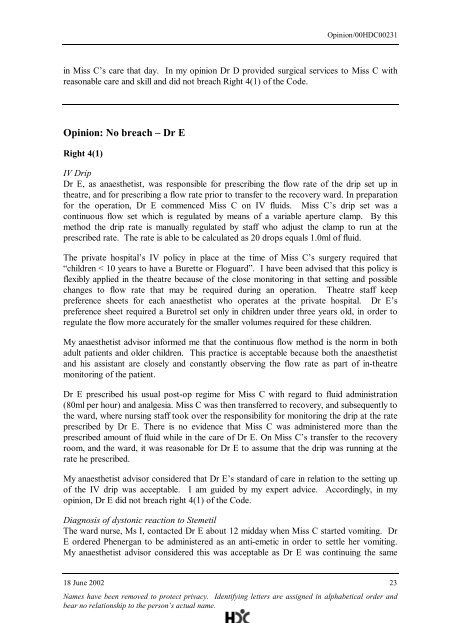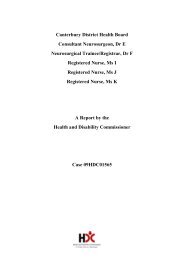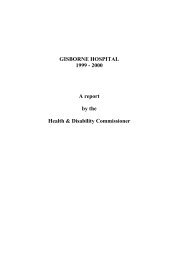Download the pdf version of this decision. - Health and Disability ...
Download the pdf version of this decision. - Health and Disability ...
Download the pdf version of this decision. - Health and Disability ...
You also want an ePaper? Increase the reach of your titles
YUMPU automatically turns print PDFs into web optimized ePapers that Google loves.
Opinion/00HDC00231<br />
in Miss C’s care that day. In my opinion Dr D provided surgical services to Miss C with<br />
reasonable care <strong>and</strong> skill <strong>and</strong> did not breach Right 4(1) <strong>of</strong> <strong>the</strong> Code.<br />
Opinion: No breach – Dr E<br />
Right 4(1)<br />
IV Drip<br />
Dr E, as anaes<strong>the</strong>tist, was responsible for prescribing <strong>the</strong> flow rate <strong>of</strong> <strong>the</strong> drip set up in<br />
<strong>the</strong>atre, <strong>and</strong> for prescribing a flow rate prior to transfer to <strong>the</strong> recovery ward. In preparation<br />
for <strong>the</strong> operation, Dr E commenced Miss C on IV fluids. Miss C’s drip set was a<br />
continuous flow set which is regulated by means <strong>of</strong> a variable aperture clamp. By <strong>this</strong><br />
method <strong>the</strong> drip rate is manually regulated by staff who adjust <strong>the</strong> clamp to run at <strong>the</strong><br />
prescribed rate. The rate is able to be calculated as 20 drops equals 1.0ml <strong>of</strong> fluid.<br />
The private hospital’s IV policy in place at <strong>the</strong> time <strong>of</strong> Miss C’s surgery required that<br />
“children < 10 years to have a Burette or Floguard”. I have been advised that <strong>this</strong> policy is<br />
flexibly applied in <strong>the</strong> <strong>the</strong>atre because <strong>of</strong> <strong>the</strong> close monitoring in that setting <strong>and</strong> possible<br />
changes to flow rate that may be required during an operation. Theatre staff keep<br />
preference sheets for each anaes<strong>the</strong>tist who operates at <strong>the</strong> private hospital. Dr E’s<br />
preference sheet required a Buretrol set only in children under three years old, in order to<br />
regulate <strong>the</strong> flow more accurately for <strong>the</strong> smaller volumes required for <strong>the</strong>se children.<br />
My anaes<strong>the</strong>tist advisor informed me that <strong>the</strong> continuous flow method is <strong>the</strong> norm in both<br />
adult patients <strong>and</strong> older children. This practice is acceptable because both <strong>the</strong> anaes<strong>the</strong>tist<br />
<strong>and</strong> his assistant are closely <strong>and</strong> constantly observing <strong>the</strong> flow rate as part <strong>of</strong> in-<strong>the</strong>atre<br />
monitoring <strong>of</strong> <strong>the</strong> patient.<br />
Dr E prescribed his usual post-op regime for Miss C with regard to fluid administration<br />
(80ml per hour) <strong>and</strong> analgesia. Miss C was <strong>the</strong>n transferred to recovery, <strong>and</strong> subsequently to<br />
<strong>the</strong> ward, where nursing staff took over <strong>the</strong> responsibility for monitoring <strong>the</strong> drip at <strong>the</strong> rate<br />
prescribed by Dr E. There is no evidence that Miss C was administered more than <strong>the</strong><br />
prescribed amount <strong>of</strong> fluid while in <strong>the</strong> care <strong>of</strong> Dr E. On Miss C’s transfer to <strong>the</strong> recovery<br />
room, <strong>and</strong> <strong>the</strong> ward, it was reasonable for Dr E to assume that <strong>the</strong> drip was running at <strong>the</strong><br />
rate he prescribed.<br />
My anaes<strong>the</strong>tist advisor considered that Dr E’s st<strong>and</strong>ard <strong>of</strong> care in relation to <strong>the</strong> setting up<br />
<strong>of</strong> <strong>the</strong> IV drip was acceptable. I am guided by my expert advice. Accordingly, in my<br />
opinion, Dr E did not breach right 4(1) <strong>of</strong> <strong>the</strong> Code.<br />
Diagnosis <strong>of</strong> dystonic reaction to Stemetil<br />
The ward nurse, Ms I, contacted Dr E about 12 midday when Miss C started vomiting. Dr<br />
E ordered Phenergan to be administered as an anti-emetic in order to settle her vomiting.<br />
My anaes<strong>the</strong>tist advisor considered <strong>this</strong> was acceptable as Dr E was continuing <strong>the</strong> same<br />
18 June 2002 23<br />
Names have been removed to protect privacy. Identifying letters are assigned in alphabetical order <strong>and</strong><br />
bear no relationship to <strong>the</strong> person’s actual name.
















